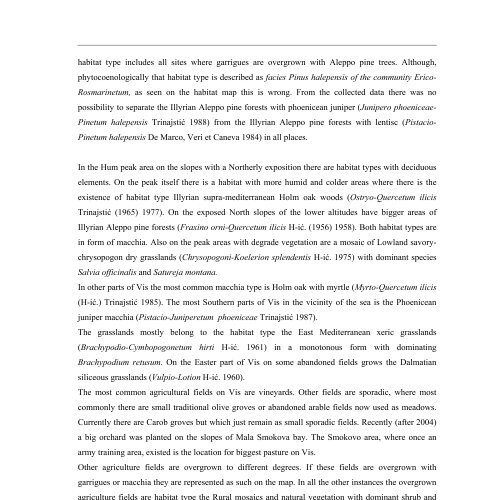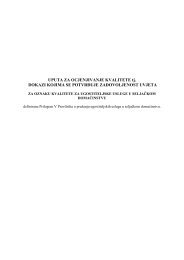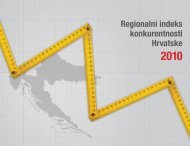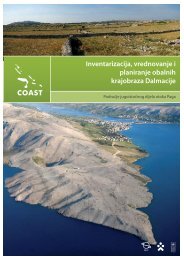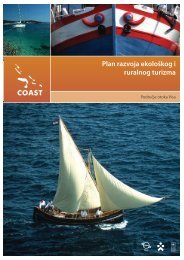PriruÄnik o kartama staniÅ¡ta Dalmacije - UNDP Croatia
PriruÄnik o kartama staniÅ¡ta Dalmacije - UNDP Croatia
PriruÄnik o kartama staniÅ¡ta Dalmacije - UNDP Croatia
- No tags were found...
Create successful ePaper yourself
Turn your PDF publications into a flip-book with our unique Google optimized e-Paper software.
habitat type includes all sites where garrigues are overgrown with Aleppo pine trees. Although,phytocoenologically that habitat type is described as facies Pinus halepensis of the community Erico-Rosmarinetum, as seen on the habitat map this is wrong. From the collected data there was nopossibility to separate the Illyrian Aleppo pine forests with phoenicean juniper (Junipero phoeniceae-Pinetum halepensis Trinajsti 1988) from the Illyrian Aleppo pine forests with lentisc (Pistacio-Pinetum halepensis De Marco, Veri et Caneva 1984) in all places.In the Hum peak area on the slopes with a Northerly exposition there are habitat types with deciduouselements. On the peak itself there is a habitat with more humid and colder areas where there is theexistence of habitat type Illyrian supra-mediterranean Holm oak woods (Ostryo-Quercetum ilicisTrinajsti (1965) 1977). On the exposed North slopes of the lower altitudes have bigger areas ofIllyrian Aleppo pine forests (Fraxino orni-Quercetum ilicis H-i. (1956) 1958). Both habitat types arein form of macchia. Also on the peak areas with degrade vegetation are a mosaic of Lowland savorychrysopogondry grasslands (Chrysopogoni-Koelerion splendentis H-i. 1975) with dominant speciesSalvia officinalis and Satureja montana.In other parts of Vis the most common macchia type is Holm oak with myrtle (Myrto-Quercetum ilicis(H-i.) Trinajsti 1985). The most Southern parts of Vis in the vicinity of the sea is the Phoeniceanjuniper macchia (Pistacio-Juniperetum phoeniceae Trinajsti 1987).The grasslands mostly belong to the habitat type the East Mediterranean xeric grasslands(Brachypodio-Cymbopogonetum hirti H-i. 1961) in a monotonous form with dominatingBrachypodium retusum. On the Easter part of Vis on some abandoned fields grows the Dalmatiansiliceous grasslands (Vulpio-Lotion H-i. 1960).The most common agricultural fields on Vis are vineyards. Other fields are sporadic, where mostcommonly there are small traditional olive groves or abandoned arable fields now used as meadows.Currently there are Carob groves but which just remain as small sporadic fields. Recently (after 2004)a big orchard was planted on the slopes of Mala Smokova bay. The Smokovo area, where once anarmy training area, existed is the location for biggest pasture on Vis.Other agriculture fields are overgrown to different degrees. If these fields are overgrown withgarrigues or macchia they are represented as such on the map. In all the other instances the overgrownagriculture fields are habitat type the Rural mosaics and natural vegetation with dominant shrub andtrees.108


